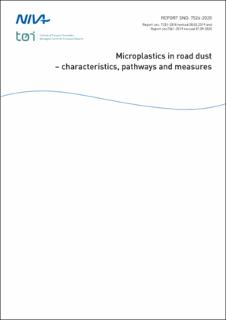| dc.contributor.author | Vogelsang, Christian | |
| dc.contributor.author | Lusher, Amy L. | |
| dc.contributor.author | Dadkhah, Mona E. | |
| dc.contributor.author | Sundvor, Ingrid | |
| dc.contributor.author | Umar, Muhammad | |
| dc.contributor.author | Ranneklev, Sissel B. | |
| dc.contributor.author | Eidsvoll, David | |
| dc.contributor.author | Meland, Sondre | |
| dc.date.accessioned | 2018-04-11T06:59:22Z | |
| dc.date.available | 2018-04-11T06:59:22Z | |
| dc.date.issued | 2020 | |
| dc.identifier.isbn | 978-82-577-7261-1 | |
| dc.identifier.issn | 1894-7948 | |
| dc.identifier.uri | http://hdl.handle.net/11250/2493537 | |
| dc.description | Project manager Christian Vogelsang. This is a revised version of report 7361-2019, which was a revised version of 7231-2018. | nb_NO |
| dc.description.abstract | The expected main contributors to road dust-associated microplastic particles (RAMP) are rubber compounds in tyre treads, polymers used to strengthen the bitumen used in road pavement and thermoplastic elastomers used in road marking paints, where the former appears to dominate. The major fraction of RAMP is expected to be found in the runoff from the road and road verge generated during rainfall events. However, even if domestic wastewater treatment plants (WWTPs) are expected to be main recipients of road runoff in urban areas, their presence in the influents or effluents (neither treated water nor sludge) have not been undisputedly documented. There is generally a complete lack of actual evidence to support the extent to which RAMP are removed by existing treatment facilities, and to what degree they are present in road runoff entering these facilities. In addition, the release of tunnel wash water is probably a major point source of RAMP. The estimated treatment efficiencies referred to in this report is based on total suspended solids (TSS) as a proxy for RAMP as well as reported particle size distributions and densities. Sedimentation is expected to be the most important mechanism for the removal of the larger size fractions if sufficient settling time is provided (traditional Norwegian gully pots do not). The report discusses the expected efficiencies of existing treatment solutions, include the roadside treatment plants, gully pots and WWTPs receiving stormwater runoff from urban areas. It also discusses other potential treatment solutions that may be applied, both along the national road network in light of the revised version of handbook N200 by the National Public Roads Administration and in urban areas with limited available space for treatment solutions. | nb_NO |
| dc.description.sponsorship | Norwegian Environment Agency | nb_NO |
| dc.language.iso | eng | nb_NO |
| dc.publisher | Norsk institutt for vannforskning | nb_NO |
| dc.relation.ispartofseries | NIVA-rapport;7526 | |
| dc.relation.ispartofseries | Miljødirektoratet-rapport;959 | |
| dc.subject | Microplastics | nb_NO |
| dc.subject | Road dust | nb_NO |
| dc.subject | Sustainable drainage systems | nb_NO |
| dc.subject | Compact treatment solutions | nb_NO |
| dc.subject | Mikroplast | nb_NO |
| dc.subject | Veistøv | nb_NO |
| dc.subject | Naturbaserte renseløsninger | nb_NO |
| dc.subject | Kompakte renseløsninger | nb_NO |
| dc.title | Microplastics in road dust – characteristics, pathways and measures | nb_NO |
| dc.type | Research report | nb_NO |
| dc.description.version | publishedVersion | nb_NO |
| dc.rights.holder | Norwegian Institute for Water Research | nb_NO |
| dc.subject.nsi | VDP::Matematikk og Naturvitenskap: 400 | nb_NO |
| dc.source.pagenumber | 118 | nb_NO |
| dc.source.issue | 7526 | nb_NO |
| dc.identifier.cristin | 1578593 | |
| dc.relation.project | 17266 | nb_NO |
